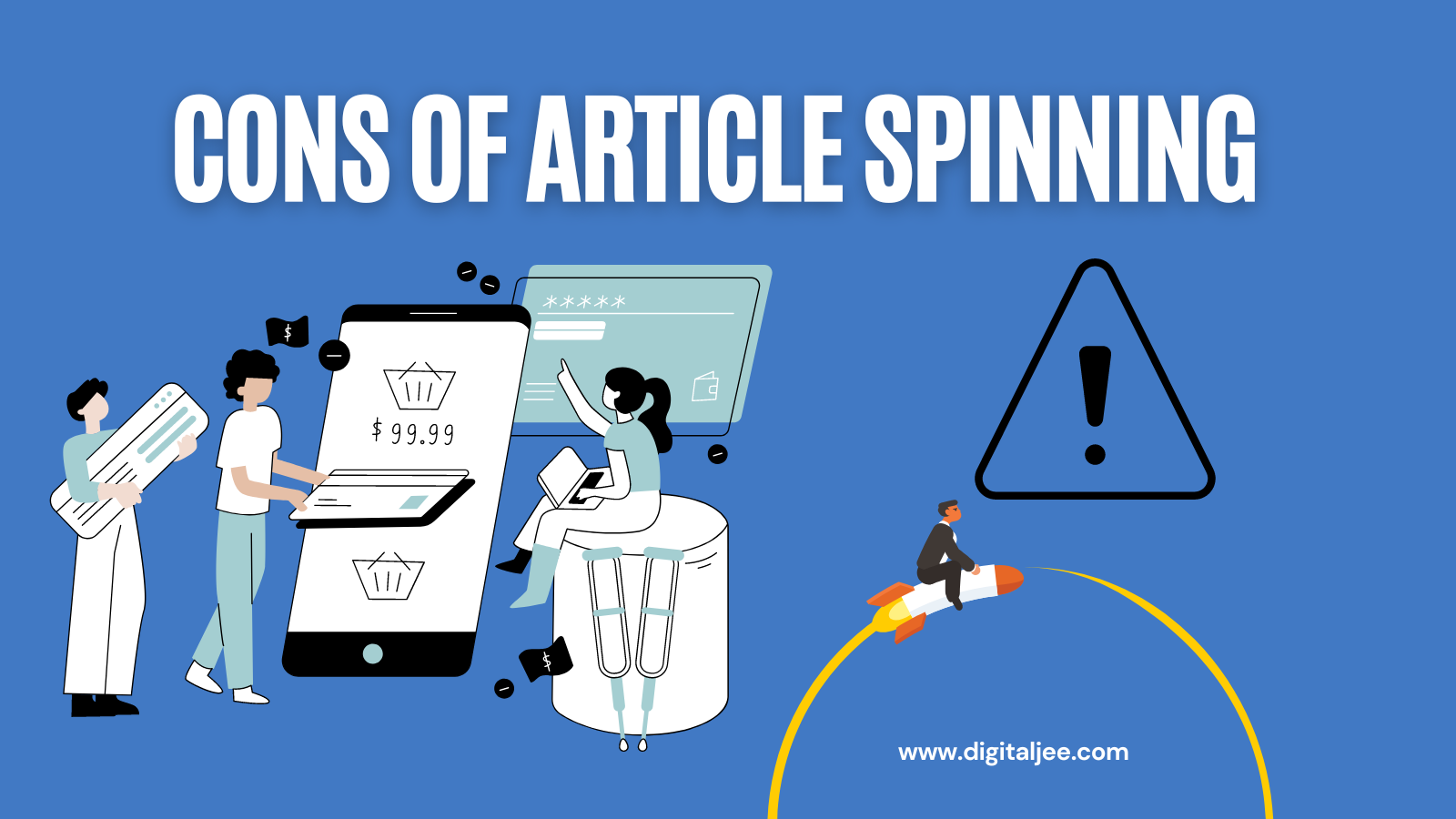In the dynamic world of Search Engine Optimization (SEO), webmasters and content creators are constantly exploring various techniques to improve their website rankings and visibility on Google search engine results pages (SERPs). One such technique that has gained both popularity and controversy is article spinning. This article aims to delve into the pros and cons of article spinning in SEO, providing you with a comprehensive understanding of this practice.
Table of contents
Related Article For You: 10 Effective White Hat SEO Techniques for Higher Rankings Must Read.
Understanding Article Spinning
Article spinning refers to the process of rewording or rephrasing existing content to create multiple unique versions of an article. This technique utilizes software tools or manual rewriting to generate new variations that supposedly avoid duplicate content penalties from search engines. The spun articles often maintain the same meaning as the original piece but present the information in a different manner.
The Pros of Article Spinning

Increased Content Production
One of the primary advantages of article spinning is the ability to generate a larger volume of content efficiently. By spinning existing articles, webmasters can create multiple versions suitable for various platforms, including article directories, guest blogging, and social media. This expanded content production can lead to increased website visibility and the potential for attracting a wider audience.
Backlink Diversification
Article spinning can help in diversifying backlinks, which is crucial for SEO success. By submitting spun articles to different platforms, websites can acquire backlinks from various sources, enhancing the overall link profile. This diversity can signal to search engines that the website is authentic and trustworthy, potentially improving search rankings.
Cost and Time Efficiency
Creating original, high-quality content can be time-consuming and costly. Article spinning offers a more efficient alternative by leveraging existing content and modifying it to suit different purposes. This approach can save both time and resources while still providing a stream of fresh content for SEO efforts.
Targeting Long-Tail Keywords
Spinn articles can be tailored to target specific long-tail keywords, which are often less competitive and more focused than broad keywords. By incorporating these keywords strategically within the spun content, websites can increase their chances of ranking higher for relevant search queries, driving targeted traffic to their pages.
The Cons of Article Spinning

Risk of Duplicate Content
While article spinning aims to create unique versions of an article, the results are not always flawless. Automated spinning tools may produce content that is still easily detectable as duplicates by search engines. If search engines identify these duplicate versions, websites may face penalties, leading to a significant drop in rankings and visibility.
Compromised Readability and Quality
This method can often result in compromised readability and quality of the content. Automated spinning tools may rearrange sentences or replace words with synonyms that do not fit well within the context. As a result, the spun articles may appear unnatural, confusing, or even nonsensical to readers. Poor-quality content can harm user experience and reputation, ultimately affecting search rankings.
Reduced User Engagement
Spinn articles, especially those produced through automated tools, lack the personal touch and genuine insights that original content offers. Readers are becoming increasingly discerning, seeking valuable and engaging information. If the content fails to meet these expectations, users may quickly navigate away from the website, leading to higher bounce rates and diminished user engagement metrics, negatively impacting SEO efforts.
Ethical Concerns
Article spinning raises ethical concerns within the SEO community. Some argue that spinning articles is akin to manipulating search engine algorithms and trying to deceive both search engines and users. It may be viewed as a black hat SEO technique, and websites caught employing such practices may suffer severe penalties, including being removed from search engine indexes altogether.
Conclusion
Article spinning in SEO is a technique that offers both advantages and disadvantages. While it can increase content production, diversify backlinks, and save time and resources, it also carries the risk of duplicate content, compromised quality, reduced user engagement, and ethical concerns. As with any SEO practice, it is important to weigh the pros and cons and make informed decisions based on the specific needs and goals of your website.
If you choose to utilize article spinning as part of your SEO strategy, it is crucial to approach it with caution and employ best practices. Manual spinning, done by skilled writers, may yield better results in terms of readability and uniqueness compared to automated spinning tools. Taking the time to thoroughly review and revise spun articles can help ensure that the content remains valuable and relevant to your audience.
However, it is worth noting that search engines are continuously evolving to detect and penalize low-quality or duplicate content. Their algorithms prioritize providing users with the best possible search results, which means that relying solely on article spinning may not be a sustainable long-term solution for improving search rankings.
Instead, it is advisable to focus on creating high-quality, original content that delivers value to your audience. By consistently producing well-researched, informative, and engaging articles, you can establish your website as a reputable source within your industry. This approach not only attracts organic traffic but also encourages natural backlinking and social sharing, which are essential elements of successful SEO.
In conclusion, while article spinning may offer some short-term benefits, it is crucial to consider the potential risks and long-term impact on your website’s SEO. Strive to create unique, compelling content that resonates with your target audience and provides genuine value. By prioritizing quality and authenticity, you can build a strong online presence that stands the test of time.
FAQs
Q1. What is article spinning in SEO?
Article spinning in SEO refers to the process of rewording or rephrasing existing content to create multiple unique versions of an article. The goal is to avoid duplicate content penalties from search engines while generating a larger volume of content.
Q2. How does article spinning benefit SEO?
Article spinning can benefit SEO in several ways. It allows for increased content production, diversification of backlinks, cost and time efficiency, and targeting of specific long-tail keywords. These benefits can potentially improve website visibility and attract a wider audience.
Q3. Are there any risks associated with article spinning?
Yes, there are risks associated with article spinning. One of the primary risks is the potential for producing duplicate content that search engines can identify. If search engines detect duplicate versions of an article, websites may face penalties, leading to a decline in rankings and visibility.
Q4. Does article spinning compromise the quality of content?
This technique can compromise the quality of content, particularly when using automated spinning tools. These tools may rearrange sentences or replace words with synonyms that do not fit well within the context, resulting in unnatural or confusing content. Poor-quality content can negatively impact user experience and SEO efforts.
Q5. Can article spinning improve search rankings?
While article spinning can have short-term benefits in terms of content production and backlink diversification, it is not a guaranteed method for improving search rankings. Search engines give priority to content that is of excellent quality, original, and delivers substantial value to users. Relying solely on spun articles may not be a sustainable long-term solution for higher search rankings.
Q6. Is article spinning an ethical SEO practice?
This technique raises ethical concerns within the SEO community. Some argue that it can be viewed as manipulating search engine algorithms and attempting to deceive search engines and users. It is important to consider the ethical implications and potential consequences before implementing article spinning as an SEO strategy.
Q7. What are some alternatives to article spinning?
Instead of relying on this method, it is advisable to focus on creating high-quality, original content. By conducting thorough research, providing valuable insights, and engaging your audience, you can establish your website as a reputable source within your industry. This approach encourages natural backlinking and social sharing, which are vital for SEO success.
Q8. How can I avoid duplicate content issues while using spun articles?
To avoid duplicate content issues when using spun articles, consider employing manual spinning done by skilled writers. They can ensure that the content remains readable, unique, and valuable to your audience. Additionally, reviewing and revising spun articles thoroughly before publishing can help minimize the risk of duplicate content.
Q9. Should I solely rely on article spinning for SEO?
No, it is not recommended to solely rely on article spinning for SEO. While it can offer some benefits, such as increased content production, it is essential to prioritize quality, authenticity, and user experience. Creating original, valuable content tailored to your target audience’s needs will yield more sustainable and long-term SEO results.
10. What should be my main focus for SEO success?
The main focus for SEO success should be on creating high-quality, original content that provides value to your audience. By prioritizing quality, relevance, and user experience, you can attract organic traffic, encourage natural backlinking, and enhance your website’s overall visibility and rankings.

